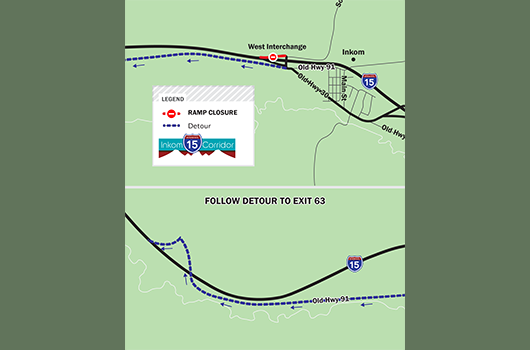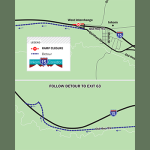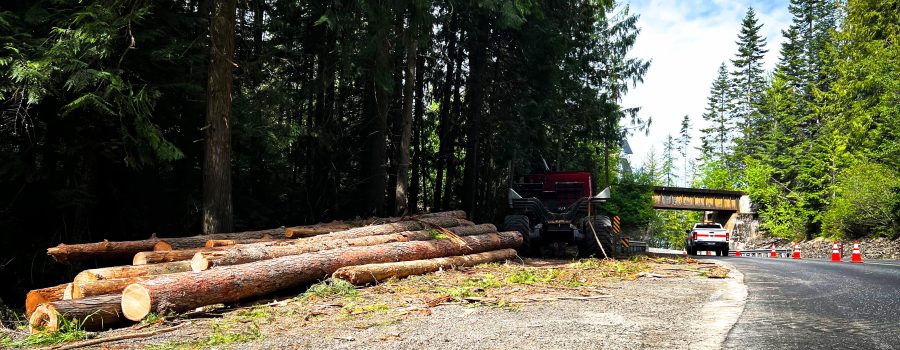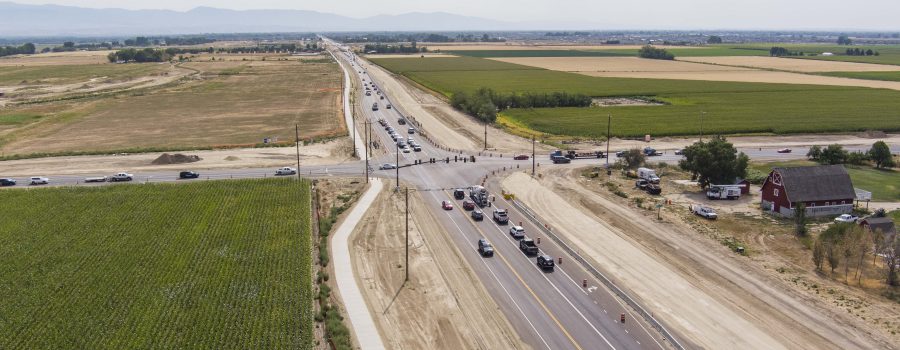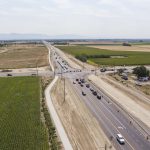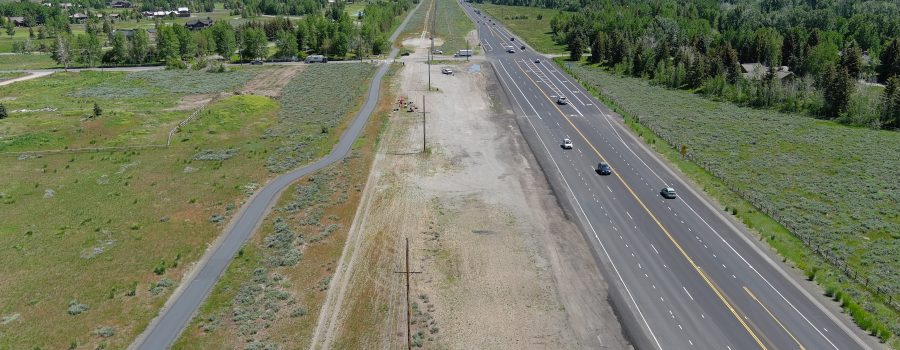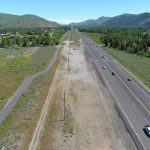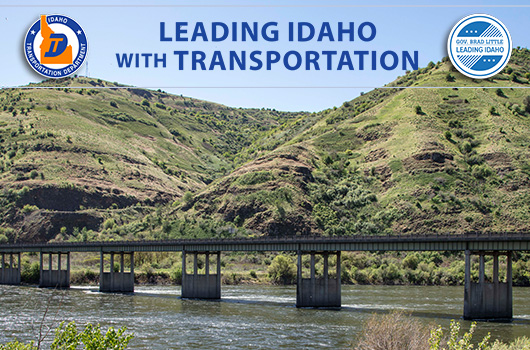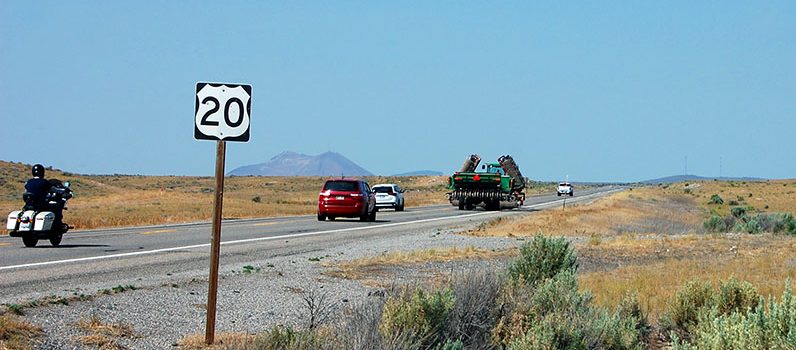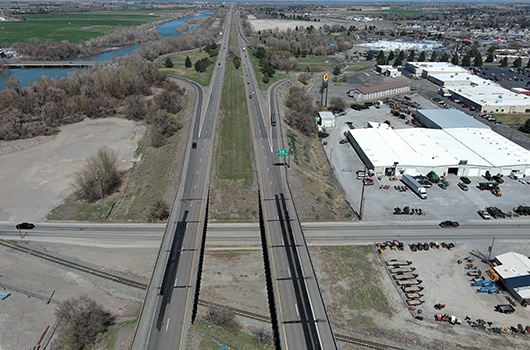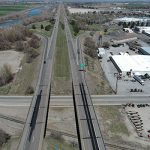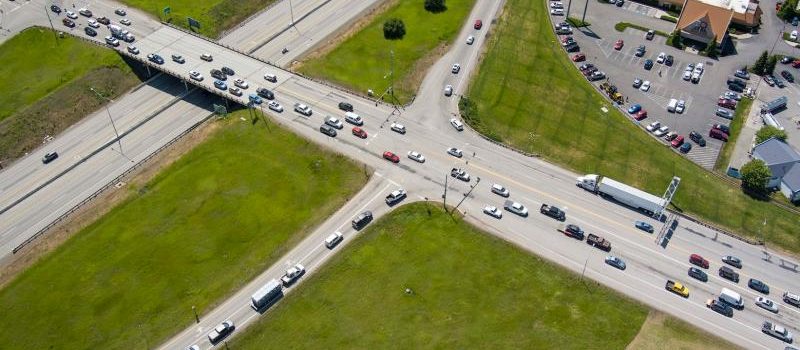Due to bridge demolition, the Inkom northbound entrance ramp onto I-15 will be closed for two nights. The West Inkom Interchange northbound entrance ramp (Exit 58) closure will take place from 9 p.m. to 6 a.m. on Monday, June 23 and Tuesday, June 24, weather and other factors permitting.
Traffic will be detoured to Old Highway 91 and then to Exit 63 to head north on I-15. Please watch for crews, use caution, and drive safely.
Due to the nature of the work, considerable noise is expected during the bridge demolition.
The Idaho Transportation Department is in the process of replacing bridges on I-15 at Inkom:
- Over the Union Pacific Railroad tracks and Old Highway 91.
- Over Rapid Creek Road (Main Street).
- I-15 bridges and reconstructing the West Interchange.
ITD combined and streamlined the projects to reduce the construction timeline to approximately two years rather than doing one location at a time over three years. This approach minimizes disruption to the local community and the traveling public and efficiently uses construction funds.
To learn more about the project or sign up for construction updates, please visit: itdprojects.idaho.gov/pages/i15-inkom-corridor. This temporary closure and other traffic impacts will be posted to 511.idaho.gov.
The Idaho Transportation Department would like to share information regarding tree removal along highways in Idaho.
The current tree clearing you may see in various locations along state routes is part of an ongoing hazard tree removal effort as part of our maintenance program to improve safety.
We prioritize removal based on the below safety benefits:
- Visibility: Clearer sightlines mean drivers can spot wildlife or obstacles sooner.
- Clear zone: Removing obstacles like trees from the clear zone around highways makes it more likely that any drivers who leave the roadway have a better chance of safely recovering and making it back to the road.
- Winter driving safety: More sunlight reaches the road surface, reducing icy conditions and the risk of black ice.
- Roadway safety: Reduces the risk of falling trees on the roadway.
- Wildfire preparedness: Removing trees near the road creates natural firebreaks that can serve to help slow or stop wildfires.
ITD is not just focusing on tree removal within our own right of way but also proactively engaging other public agency partners, such as the U.S. Forrest Service and Idaho Parks and Recreation, to bring these safety benefits along more of our highways.
In instances where there is a need to address trees on private property we work collaboratively with property owners and get express permission before proceeding with tree removal. We do not remove trees on private land without permission.
It’s also important to understand that not all tree removal you may see along highways is being performed by ITD. Private property owners and timber operations often conduct logging or thinning near roadways, and while we require permits for any work within our right of way that we are not initiating, many of these operations happen entirely on private land.
We understand that Idahoans value our outdoor spaces and the area’s natural beauty. Every decision we make on hazard trees is made with the intent of saving lives.
We’re committed to being transparent about our work and welcome any questions from the public. The public can always reach out directly to ITD for accurate information from district representatives.
Tomorrow the Idaho Transportation Department will begin repaving the southbound lanes of Interstate 15 from the Rose/Firth Exit 98 to one mile north of West Blackfoot Exit 93. Traffic will be reduced to one lane in each direction and moved over to the northbound side of I-15.
The project will reconstruct the road to address rutting and potholes. Work is anticipated to be completed in mid-August. The northbound lanes were similarly repaved last year.
Motorists should carefully follow signs and posted speed limits while traveling through the construction area and are encouraged to use 511.idaho.gov or the 511 app to keep track of project detours.
BOISE — The Idaho Division of Motor Vehicles is encouraging all eligible Treasure Valley residents to renew their driver’s licenses online at dmv.idaho.gov.
DMV offices across the region are experiencing higher-than-normal in-person traffic. Renewing online helps reduce wait times, ensures faster service for those who must visit in person, and supports hardworking DMV staff.
Who can renew online?Most Idahoans can renew online if they are a U.S. citizen or lawful permanent resident, their license hasn’t been expired for more than 24 months, they are between the ages of 18 and 66, and there have been no recent changes to their vision or ability to operate a vehicle safely. Additional restrictions may apply.
Existing Star Card holders may be eligible to renew their credential online. First time Star Card applications must be processed in person at a local driver’s license office.
Skip the Trip and save time. Renew today at dmv.idaho.gov.
Since Transportation Expansion and Congestion Mitigation funds were first used by the department for bonding and advancing major projects in 2022, ITD has delivered timely construction of expansion projects across the state. Today’s actions are a continuation of that.
Funding came from House Bill 25, which was passed by the Idaho Legislature earlier this year. The legislation provides an additional $20 million a year to the TECM fund for the next three years and allows the department to invest an extra $1 billion in the Idaho transportation system.
With this new funding, the following projects have been recommended for further design and construction:
- SH-16 from SH-44 to Beacon Light: This project will increase capacity by widening the road from two to four lanes with a median barrier between the future SH-44 Interchange and Beacon Light Road. An overpass will be added at Floating Feather Road. Construction is anticipated to start in 2027, one year earlier than planned.
- I-84 Mobility Improvements: The ongoing study will provide a prioritized list of operational improvements like auxiliary lanes between Boise and Nampa, and this revenue stream will provide construction funding for the highest priority needs that emerge from the study.
- US-20/26 from Middleton to Star: This project will add capacity by widening the road to two lanes in both directions and improve safety by adding a continuous center turn lane. Construction is anticipated to start in 2026, four years earlier than planned.
- SH-44 from Star to SH-16: This project will add capacity by widening the road from three to five lanes between Mira Avenue and Moyle Ave. It includes resurfacing between Star Road and Mira Ave. Construction is anticipated to start in 2027, two years earlier than planned. Download a photo of the SH-44 and SH-16 intersection.
With these projects now included in the draft Idaho Transportation Investment Program (ITIP), the public will have the opportunity to give feedback on these projects and the department’s full list of planned projects from 2026-2032 during the annual comment period in July. Then the draft ITIP will be presented to the board for approval in September.
The board’s action today reflects continued investment targeting congestion and capacity in major corridors that were previously funded by TECM bonds as authorized by the Idaho Legislature. In Southwest Idaho, TECM funds have successfully extended SH-16 from I-84 to US-20/26 including the construction of five new interchanges, with the corridor set to open by 2027. These funds also allowed SH-55 to be widened to two lanes in each direction from Farmway Road to Middleton Road, with work set to be done in 2027.
These latest projects were identified because they are existing high-priority corridor needs that will improve traffic flow and increase safety.
Today at its regular monthly meeting the Idaho Transportation Board accepted staff recommendations on priority corridors across Idaho using TECM funds to address congestion, including State Highway 75 north of Hailey. Since Transportation Expansion and Congestion Mitigation funds were first used by the department for bonding and advancing major projects in 2022, ITD has delivered timely construction of expansion projects across the state. Today’s actions are a continuation of that.
Funding came from House Bill 25, which was passed by the Idaho Legislature earlier this year. The legislation provides an additional $20 million a year to the Transportation Expansion and Congestion Mitigation fund for the next three years and allows the department to invest an extra $1 billion in the Idaho transportation system.
With this new funding, SH-75 from McKercher Boulevard to Broadway Run has been recommended for advanced construction. This project will add capacity by widening the road to two lanes in each direction. Safety will be enhanced with a continuous center turn lane and pedestrian/transit improvements. Construction is anticipated to start in 2026, one year earlier than planned.
With this project now included in the draft Idaho Transportation Investment Program (ITIP), the public will have the opportunity to give feedback on this project and the department’s full list of planned projects from 2026-2032 during the annual comment period in July. Then the draft ITIP will be presented to the board for approval in September.
The board’s action today reflects continued investment targeting congestion and capacity in major corridors that were previously funded by TECM bonds as authorized by the Idaho Legislature. In South-central Idaho, TECM funds are funding the widening of I-84 from Jerome to Twin Falls, and full reconstruction of the Burley and Heyburn Interchanges.
This project and others were identified because they are existing high-priority corridor needs that will improve traffic flow and increase safety.
Today at its regular monthly meeting the Idaho Transportation Board accepted staff recommendations on priority corridors across Idaho using TECM funds to address congestion, including the Spalding Bridge on U.S. Highway 95 east of Lewiston. Since Transportation Expansion and Congestion Mitigation funds were first used by the department for bonding and advancing major projects in 2022, ITD has delivered timely construction of expansion projects across the state. Today’s actions are a continuation of that.
Funding came from House Bill 25, which was passed by the Idaho Legislature earlier this year. The legislation provides an additional $20 million a year to the Transportation Expansion and Congestion Mitigation fund for the next three years and allows the department to invest an extra $1 billion in the Idaho transportation system.
Prior to House Bill 25, no funding was available for construction; now it could begin at the earliest in 2028. This project will replace the existing Spalding Bridge with two wider bridges and add capacity to the existing US-95 and US-12 Interchange.
With this project now included in the draft Idaho Transportation Investment Program (ITIP), the public will have the opportunity to give feedback on this project and the department’s full list of planned projects from 2026-2032 during the annual comment period in July. Then the draft ITIP will be presented to the board for approval in September.
The board’s action today reflects continued investment targeting congestion and capacity in major corridors that were previously funded by TECM bonds as authorized by the Idaho Legislature. In North-central Idaho, TECM funds had previously allowed ITD to start design of this bridge and the nearby Arrow Bridge.
This project and others were identified because they are existing high-priority corridor needs that will improve traffic flow and increase safety.
Today at its regular monthly meeting the Idaho Transportation Board accepted staff recommendations on priority corridors across Idaho using TECM funds to address congestion, including several projects on U.S. Highway 20 near Idaho Falls. Since Transportation Expansion and Congestion Mitigation funds were first used by the department for bonding and advancing major projects in 2022, ITD has delivered timely construction of expansion projects across the state. Today’s actions are a continuation of that.
Funding came from House Bill 25, which was passed by the Idaho Legislature earlier this year. The legislation provides an additional $20 million a year to the Transportation Expansion and Congestion Mitigation fund for the next three years and allows the department to invest an extra $1 billion in the Idaho transportation system.
With this new funding, the following projects have been recommended for further design and construction:
- US-20 west of Idaho Falls: This project will increase capacity by widening the road to two lanes in each direction starting at Idaho Falls and moving west as funding allows. Widening will increase safety for freight, recreational and commuter traffic due to limited passing opportunities and lines of sight. Construction is anticipated start in 2026, two years earlier than planned.
- US-20 widening from Chester to Ashton: This project is anticipated to expand the existing roadway into a four-lane divided highway. Construction is anticipated to start in 2028.
- I-15 and US-20 Interchange: This project continues to make progress toward relocating I-15 Exit 119 to US-20 and realign US-20 through Idaho Falls to address safety and congestion concerns. Funding will allow for the purchase of private property for future construction.
With these projects now included in the draft Idaho Transportation Investment Program (ITIP), the public will have the opportunity to give feedback on this project and the department’s full list of planned projects from 2026-2032 during the annual comment period in July. Then the draft ITIP will be presented to the board for approval in September.
The board’s action today reflects continued investmenttargeting congestion and capacity in major corridors that were previously funded by TECM bondsas authorized by the Idaho Legislature. In East Idaho, TECM funds allowed for the construction at the South St. Anthony Interchange, which was previously unfunded.
This project and others were identified because they are existing high-priority corridor needs that will improve traffic flow and increase safety.
Today at its regular monthly meeting the Idaho Transportation Board accepted staff recommendations on priority corridors across Idaho using TECM funds to address congestion, including three projects on Interstate 15 near Blackfoot. Since Transportation Expansion and Congestion Mitigation funds were first used by the department for bonding and advancing major projects in 2022, ITD has delivered timely construction of expansion projects across the state. Today’s actions are a continuation of that.
Funding came from House Bill 25, which was passed by the Idaho Legislature earlier this year. The legislation provides an additional $20 million a year to the Transportation Expansion and Congestion Mitigation fund for the next three years and allows the department to invest an extra $1 billion in the Idaho transportation system.
With this new funding, the following projects have been recommended for advancing to construction:
- I-15 and US-26 Interchange (Exit 93): The existing interchange will be replaced to accommodate additional lanes on the interstate and to include longer on- and off-ramps for safer merging. Construction is anticipated to start in 2026, five years earlier than planned.
- I-15 widening from milepost 89 to 93: This project will add capacity by widening the interstate to three lanes in each direction between the US-26 Interchange and the South Blackfoot Interchange. Construction was previously not funded but is now anticipated to start in 2027.
- I-15 and US-91 South Blackfoot Interchange (Exit 89): The existing interchange will be upgraded to accommodate additional lanes on the interstate and include longer on- and off-ramps for safer merging. Construction is anticipated to start in 2028, three years earlier than planned.
With these projects now included in the draft Idaho Transportation Investment Program (ITIP), the public will have the opportunity to give feedback on this project and the department’s full list of planned projects from 2026-2032 during the annual comment period in July. Then the draft ITIP will be presented to the board for approval in September.
The board’s action today reflects continued investment targeting congestion and capacity in major corridors that were previously funded by TECM bonds as authorized by the Idaho Legislature. TECM funds have allowed for the construction of the I-86 and I-15 System Interchange in Pocatello, as well as the widening of I-15 from Northgate to Fort Hall.
These projects were identified because they are existing high-priority corridor needs that will improve traffic flow and increase safety.
Today at its regular monthly meeting the Idaho Transportation Board accepted staff recommendations on priority corridors across Idaho using TECM funds to address congestion, including the Interstate 90 in Coeur d’Alene. Since Transportation Expansion and Congestion Mitigation funds were first used by the department for bonding and advancing major projects in 2022, ITD has delivered timely construction of expansion projects across the state. Today’s actions are a continuation of that.
Funding came from House Bill 25, which was passed by the Idaho Legislature earlier this year. The legislation provides an additional $20 million a year to the Transportation Expansion and Congestion Mitigation fund for the next three years and allows the department to invest an extra $1 billion in the Idaho transportation system.
With this new funding, the I-90 and US-95 Interchange has been recommended for further design and construction. This project will add capacity to support future traffic volumes, which are expected to double by 2045, and enhance safety by eliminating off-ramp queues backing up on to the interstate. Prior to House Bill 25, no funding was available for construction; now it could be possible as early as 2027.
With this project now included in the draft Idaho Transportation Investment Program (ITIP), the public will have the opportunity to give feedback on this project and the department’s full list of planned projects from 2026-2032 during the annual comment period in July. Then the draft ITIP will be presented to the board for approval in September.
The board’s action today reflects continued investment targeting congestion and capacity in major corridors that were previously funded by TECM bonds as authorized by the Idaho Legislature. In North Idaho, TECM funds allowed construction of the I-90 and State Highway 41 Interchange to begin in 2022, a year earlier than planned. It will also allow the expansion of I-90 to four lanes in both directions between SH-41 and US-95 to begin this summer.
This project and others were identified because they are existing high-priority corridor needs that will improve traffic flow and increase safety.
